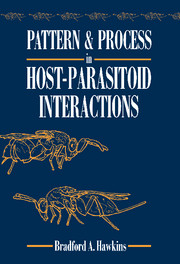2 - Data and methodology
Published online by Cambridge University Press: 04 May 2010
Summary
Introduction
All of the results reported in this monograph are based on analyses of data sets generated by extracting information from an extensive global literature. Because the bulk of the data was originally collected and reported by workers for reasons unrelated to how I use them, a proper evaluation of the patterns and their significance hinges on an understanding of the structure of the data sets, their scope, and their limitations. This chapter provides details on data collection and analytical methodology. I first describe the data sets on which the analyzes are based, representing primary parasitoid and hyperparasitoid assemblage sizes, levels of parasitoid–induced host mortality, and the outcomes of biological control introductions using parasitoids. I then define the independent and dependent variables actually analyzed and, finally, I briefly describe the statistics used.
Parasitoid species richness
The data quantifying parasitoid assemblage size, defined as the number of parasitoid species per herbivorous host species, consist of lists of parasitoid species recorded from individual host species from four orders of holometabolous herbivorous insects (Coleoptera, Diptera, Lepidoptera and Hymenoptera). Herbivory is defined in its broad sense and includes insects that feed on either dead or living plant tissues, as well as those feeding on fungusinfested tissues. Generally, lists were generated from primary literature sources, with a few exceptions. Only hosts studied within their presumed native ranges were included.
Information
- Type
- Chapter
- Information
- Pattern and Process in Host-Parasitoid Interactions , pp. 5 - 22Publisher: Cambridge University PressPrint publication year: 1994
